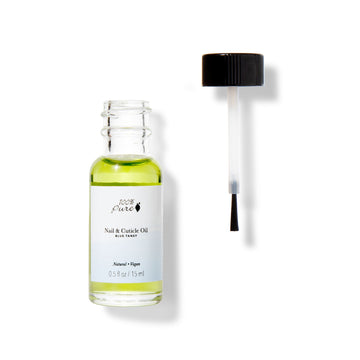Pondering the nature of nail polish, and how close to ‘natural’ it can actually get
Written by: 100% PURE ®
Whether you’re a novice or expert on your clean beauty journey, shopping for ‘natural’ nail colors has likely left you stumped.
We’ve all given ourselves an impromptu mani-pedi complete with our nail color of choice. And have you ever used nail polish that didn’t reek of chemicals? How does nail polish even get labeled as ‘natural’ when it seems to be anything but?
We’re always in support of a beauty routine that’s better for your body and the environment, and we wholeheartedly encourage anyone who’s in pursuit of a more natural manicure. But we’ll warn you now: natural nail polish can be a tricky pursuit.
About a decade ago, clean and natural beauty products were a lot harder to find.
More often than not you'd only be able to find your natural products at health food stores. Options would be few and far between at traditional makeup retailers, and don’t even get us started on cruelty-free options.
Luckily, the beauty industry has evolved for the better when it comes to more natural beauty options. As both mainstream and indie brands have come to develop more natural formulas, it’s becoming increasingly safe to say that ‘clean beauty’ is becoming the standard for beauty.
But what defines natural or clean beauty?
Here’s the tricky thing: there is currently no official definition of clean beauty. That is to say, there’s been no definition issued by a federal entity such as the FDA.
Consequently, the definition of “clean beauty” is up to a brand’s interpretation, and some brands take advantage of this by simply marketing their products as “clean” or “natural” without specifying what they mean.
At 100% PURE, we define “natural” as an ingredient or formula composed of plant, mineral, and/or marine vegetation that undergoes chemical changes due to biological processes such as fermentation, distillation, and cold processing.
This means that we adhere to strict purity standards, use natural pigments, and never test ingredients or finished products on animals. Clean beauty is becoming the standard, so having a clear definition will help you keep your own standards high when determining what to buy.
So how can these standards translate to the niche market of nail polish?

Most have a general understanding of common toxic ingredients in beauty products. But how can this knowledge help us find a natural nail color?
Discerning the “bad” ingredients in nail lacquers has been a challenge. Luckily, our understanding of natural nail polish has reached a point of rapid growth.
We have a fairly comprehensive notion of the ingredients in nail polish that are toxic. However, the list of toxic ingredients is almost like a sliding scale. Generally, it’s believed that there are ultimately three ingredients natural nail colors should avoid: toluene, dibutyl phthalate (DBP), and formaldehyde. But there are actually as many as fifteen ingredients some companies will leave out, deeming too ‘toxic’ for their formulas.
These brands will typically state themselves as anywhere from “3-free” to “7-free” to “15-free”, and the lists may vary depending on the brand. Here’s a breakdown of how natural nail colors avoid toxins:
3-FREE
Toluene, dibutyl phthalate (DBP), and formaldehyde
5-FREE
Formaldehyde, toluene, DBP, formaldehyde resin, camphor
7-FREE
Formaldehyde, toluene, DBP, formaldehyde resin, camphor, ethyl tosylamide, xylene
9-FREE
Formaldehyde, toluene, DBP, formaldehyde resin, camphor, ethyl tosylamide, xylene, parabens, acetone
10-FREE
Formaldehyde, toluene, DBP, formaldehyde resin, camphor, ethyl tosylamide, xylene, parabens, acetone, TPHP, TBHP, gluten
15-FREE
Formaldehyde, formaldehyde resin, DBP, toluene, camphor, ethyl tosylamide, xylene, TPHP, parabens, bismuth, MIT, MEHQ, gluten, fragrance, animal derivatives

Now, to address the trickiness behind finding a good natural nail color. Is they’re truly a natural nail color out there that’s made of 100% natural ingredients?
In a word, no. Nail polishes need to perform in a way that no other product does: while lipsticks and eyeshadows just need to last a matter of hours, nail polish is expected to adhere to the surface of our nails, and ideally for several days to weeks.
For this reason, nail colors are, quite simply, inherently unnatural. And with today’s technology, fruit-based pigments just can't cut it.
Aside from the natural nail polish ideals mentioned above, there’s been another interesting movement in the industry: water-based formulas.
Water-based nail polish was something we first saw in the 90s and early 2000s, and they were largely marketed to children with an interest in nail polish.
This was for two reasons: water-based nail polish is considered non-toxic, and it doesn’t last very long. When it hit the adult beauty market, using water-based nail polish kind of felt like using watercolor paint on your nails. It was streaky, inconsistent, and it didn’t last more than a day.
In 2021, we’re seeing a comeback in water-based formulas. With evolved technology and wider understanding of formulations, they’ve improved a little. Sadly, they still fail to perform as well as conventional nail polishes; and yet, many will argue that they’re nonetheless the safest option in natural nail color.
For now, water-based formulas simply aren’t up to standard, but we’re interested in what the future of water-based has to offer.
However, sticking to the options with more natural ingredients is worth it in the long run. There are also ways to keep our cuticles healthy, despite harsh nail color formulas. After all, the cuticles are designed for protection, so it’s important that they stay nourished and moisturized.
If you’re inspired to improve your nail care, discover the best tips for healthy nails. We’ve also compiled our list of the most high-performance natural nail color brands!
We carefully hand-select products based on strict purity standards, and only recommend products we feel meet this criteria. 100% PURE™ may earn a small commission for products purchased through affiliate links.
The information in this article is for educational use, and not intended to substitute professional medical advice, diagnosis, or treatment and should not be used as such.



